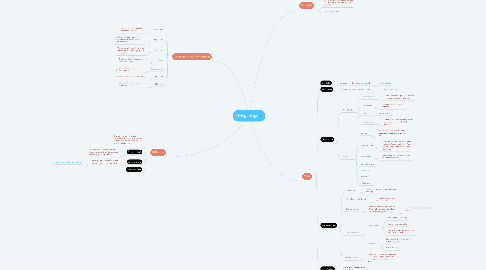
1. Characteristics (MRSGREN)
1.1. Movement
1.1.1. Move the body to change positions or places
1.2. Respiration
1.2.1. Breathe so that we can take in oxygen and take out the carbon dioxide to live
1.3. Sensitivity
1.3.1. We sense with our 5 senses to detect our surroundings and to avoid danger
1.4. Growth
1.4.1. To grow and learn new things in order to survive
1.5. Reproduction
1.5.1. To increase the number of that specific organism
1.6. Excretion
1.6.1. To take out the waste in the body
1.7. Nutrition
1.7.1. To absorb energy and grow or repair your body
2. Cells
2.1. Unicellular
2.1.1. an organism that has only one cell
2.1.1.1. Ex. Protozoa
2.2. Multicellular
2.2.1. an organism that has many cells
2.2.1.1. Ex. Human, cat, dog
2.3. Cell structure
2.3.1. Animal cells
2.3.1.1. cell membrane
2.3.1.1.1. holds the cell together & controls substance going in and out
2.3.1.2. cytoplasm
2.3.1.2.1. different chemical process happens
2.3.1.3. nucleus
2.3.1.3.1. contains DNA
2.3.1.4. mitochondria
2.3.1.4.1. Takes in nutrients, breaks it down, and creates molecules full of energy.
2.3.2. Plant cells
2.3.2.1. cell wall
2.3.2.1.1. contains cellulose to have extra support and protections for the cells
2.3.2.2. large vacuole
2.3.2.2.1. contains cell sap and is used for storage of some materials. The cell sap helps the plant to keep it's shape.
2.3.2.3. chroloplasts
2.3.2.3.1. contains chlorophyll which is used for photosynthesis
2.3.2.4. cell membrane
2.3.2.5. cytoplasm
2.3.2.6. nucleus
2.3.2.7. mitochondria
2.4. Specialized cells
2.4.1. Ciliated cells
2.4.1.1. Moves through mucus and cleans the lung
2.4.2. Palisade mesophyll cells
2.4.2.1. contain large number of chloroplasts
2.4.3. Red blood cells
2.4.3.1. made in bone marrow and are filled with haemaglobin which bonds with oxygen.
2.4.3.1.1. Carries thepxygen to the whole body.
2.4.4. Human sex cells
2.4.4.1. sperm cell
2.4.4.1.1. has streamlined body
2.4.4.1.2. has tail to move faster
2.4.4.1.3. has acrosome to fuse with egg cell's nucleus easily
2.4.4.2. egg cell
2.4.4.2.1. large amount of cytoplasm containing food
2.4.4.2.2. has a jelly coat
2.4.5. Root hair cells
2.4.5.1. water and minerals are absorbed by this and it helps to absoeb more by having a large surface area.
2.5. Magnification
2.5.1. actual size=observed size ÷ magnification
3. Diffusion
3.1. The net movement of the particles when they try to move to the place where there is lower concentration.
3.2. Net movement
3.2.1. The movement of the particles when the majority of the particles are moving in one direction.
3.3. cell membrane
3.3.1. lets in the small particles in and out but not the large particles
3.3.1.1. it means it's partially parmeable
